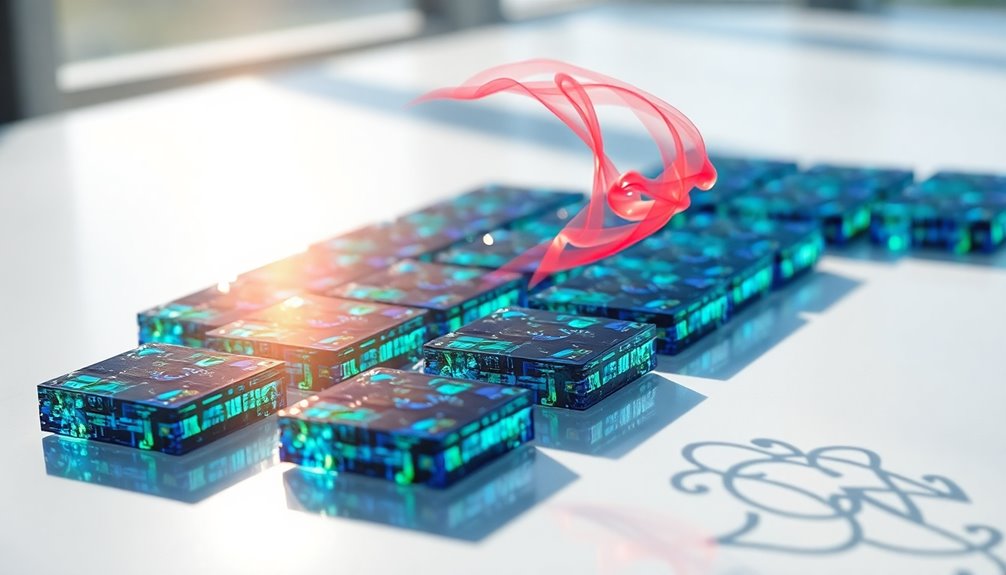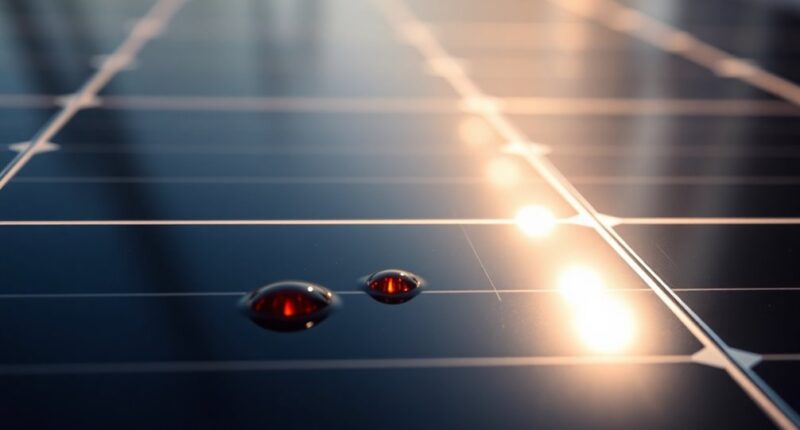Wide-bandgap solar cells are getting a boost from reductive cations in air. This innovation enhances their stability and efficiency, addressing key issues like performance under continuous illumination. With these advancements, you'll find they can optimize energy capture, especially in tandem solar cells and indoor applications. Plus, ongoing research is paving the way for safer, lead-free alternatives without sacrificing effectiveness. Explore how these developments continue to shape the future of solar energy technology.
Key Takeaways
- Reductive cations in air enhance the stability of wide-bandgap solar cells' perovskite structures, improving performance under continuous illumination.
- This innovation leads to increased efficiency and extended lifespan for wide-bandgap solar cells, crucial for sustainable energy solutions.
- The incorporation of reductive cations allows for better absorption of high-energy photons, maximizing voltage generation.
- Enhanced stability from reductive cations makes wide-bandgap solar cells more suitable for tandem configurations and indoor applications.
- Ongoing research into reductive cations addresses stability challenges, paving the way for safer, lead-free alternatives in solar technology.

Wide-bandgap solar cells, which are semiconductors with a bandgap greater than 1.6 eV, play a crucial role in advancing solar technology. These cells often utilize perovskites or other tunable materials to capture more sunlight, especially in tandem configurations. By absorbing high-energy photons, they generate higher voltages, enhancing overall efficiency. With the ability to achieve efficiencies over 20%, these cells are paving the way for significant advancements in solar energy applications.
One exciting development in this field is the incorporation of reductive cations in air, which can boost the performance of wide-bandgap solar cells. This technique involves using specific cations that help stabilize the perovskite structure, addressing stability issues that have plagued these materials. As you explore this innovative approach, you'll find that it not only enhances efficiency but also extends the lifespan of solar cells under continuous illumination.
The applications of wide-bandgap solar cells are diverse. They excel in tandem solar cells as top layers, effectively capturing high-energy photons while increasing overall efficiency. Additionally, they're perfect for indoor photovoltaics, where they can be tuned to perform well under artificial lighting conditions. In agrivoltaics, they allow sunlight to pass through while absorbing harmful high-energy rays, contributing to improved crop yields. Furthermore, tunable band gaps enhance the versatility of these cells for various applications.
Despite their advantages, challenges remain. Stability under continuous illumination, toxicity concerns with lead-based materials, and scalability issues all need addressing. However, research into lead-free alternatives is gaining momentum, promising safer options without sacrificing performance.
Technical advances like defect passivation and optimized tandem structures are essential for overcoming these hurdles. By modifying surface properties and enhancing carrier mobility, researchers are working to ensure that wide-bandgap solar cells not only perform efficiently but also meet long-term sustainability goals.
With ongoing innovations, these solar cells hold great promise for the future of renewable energy.
Frequently Asked Questions
What Are the Advantages of Wide-Bandgap Solar Cells Over Traditional Cells?
Wide-bandgap solar cells offer several advantages over traditional cells.
You'll find they can achieve higher efficiencies, often exceeding 25%, and their tuneable bandgap allows for optimization based on light conditions.
They're also semi-transparent, making them ideal for innovative applications like solar windows.
Plus, their lightweight and flexible nature means they're suitable for diverse installations.
With improved stability and cost-effective manufacturing, these cells represent a promising advancement in solar technology.
How Does Temperature Affect the Performance of Wide-Bandgap Solar Cells?
Imagine you're on a sun-soaked roof, watching your solar panels work.
As temperatures rise, wide-bandgap solar cells shine brighter in efficiency compared to traditional silicon cells. They lose less performance, with their open circuit voltage declining but short circuit current slightly increasing.
This balance allows them to maintain functionality even in extreme heat, making them ideal for high-temperature applications.
What Materials Are Commonly Used in Wide-Bandgap Solar Cells?
When you explore wide-bandgap solar cells, you'll find that perovskites are among the most commonly used materials due to their tunable bandgap and high absorption coefficients.
Silicon is often combined with these perovskites in tandem devices to boost efficiency. Additionally, mixed halide anions enhance stability and performance, while tin-lead perovskites show promise for all-perovskite tandem solar cells.
These materials are paving the way for more efficient and reliable solar energy solutions.
Are There Any Environmental Concerns With Wide-Bandgap Solar Cell Production?
Imagine a factory humming like a busy bee, but beneath that buzz lies concern.
Yes, there are environmental issues with wide-bandgap solar cell production. The mining for materials can strip landscapes, while energy-intensive manufacturing can puff greenhouse gases into the air.
Hazardous chemicals are also part of the mix, needing careful disposal.
If you're considering this technology, it's vital to weigh these impacts against the benefits of cleaner energy.
How Do Wide-Bandgap Solar Cells Compare in Efficiency to Other Solar Technologies?
When you compare wide-bandgap solar cells to other technologies, you'll find they typically lag behind in efficiency.
For instance, Cu(In,Ga)Se2 (CIGS) cells achieve efficiencies over 18%, while wide-bandgap variants struggle to reach 15%.
In contrast, silicon cells often exceed 20% efficiency.
However, wide-bandgap cells shine in tandem applications, where they can complement other materials, enhancing overall energy capture and making them valuable for advanced solar solutions despite their current limitations.
Conclusion
In the quest for energy solutions, wide-bandgap solar cells shine like a beacon of hope, fueled by the innovative use of reductive cations. This breakthrough not only enhances efficiency but also symbolizes our relentless pursuit of sustainable power. As you embrace these advancements, remember that every step toward harnessing the sun's energy is a stride toward a brighter, greener future. Together, we're transforming challenges into opportunities, illuminating a path for generations to come.









